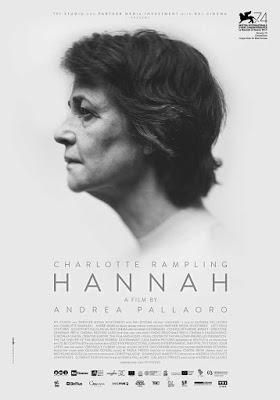
Hannah is the second film of Italian director Andrea Pallaoro—and, according to him, it is the second film of a trilogy of films he is making which appear to be having a commonthread of a woman internally reassessing her relationship to her family members over time.One would often expect a female director to grapple with such subjects but here is a male director getting inside the female mind.All three films in the trilogy are original scripts, all co-scriptedby him and his friend Orlando Tirado, a team that has worked not only on the trilogy but also on an early short film called Wunderkammer (2008) again on that very theme.
His debut film and the first of the trilogy was Medeas (2013) which won him awards at Venice, Tbilisi, Marrakesh, Nashville, and Palm Spring international film festivals.His cinematographer Canadian/American Chayse Irvin won the prestigious Cameraimage cinematography prize and a Special Jury prize at the Nashville film festival for his contribution in Medeas. Pallaoro’s direction of Colombian actress Catalina Sandino Moreno won her an acting award at Nashville. The third film has the title Monica and is under production.
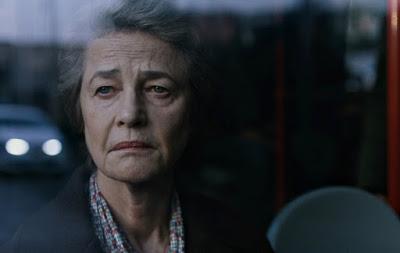
Hannah (Rampling) alone and sad riding a public bus,
reflecting on her predicament
With an interesting recognition of his debut feature film Medeas, it is not surprising that Pallaoro’s second feature film Hannah almost replicates some of the remarkable achievements of his debut film. Hannah’s lead actress Charlotte Rampling won the deserving Best Actress Award at the Venice film festival. Once again, cinematographer Canadian/American Chayse Irvin won an award for his work in another Pallaoro film, this time a Silver Hugo for Hannah from the Chicago film festival.The citation for that honor is very appropriate and insightful and reads as follows:
"Hannah tells the story of a very guarded woman and is itself a guarded film, refusing to spell out the motives or contexts behind a lonely woman's behavior. The images, then, must convey feelings and ideas that the screenplay and character will not. Through meticulous composition, unexpected framing, and a finely calibrated color palette, they do just that."
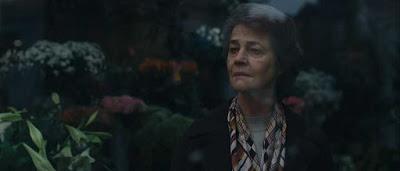
The color captured by cinematographer Irvin,
for a shot where Hannah is briefly recalling her good times
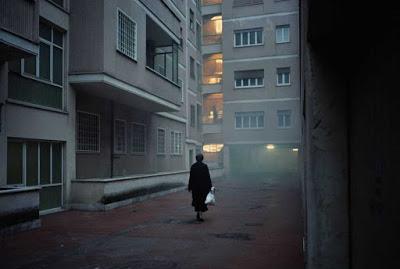
Bleak, muted colours for an important sequence as Hannah walks to throw
an important incriminating item in the garbage, when apartments
appear to suggest prison cells
The team of Andrea Pallaoro, Orlando Tirado and Chayse Irvin obviously constitute a talented trio and they are getting well-deserved international recognition. (That Hannah has got a low IMDB user rating is arguably not a fair indicator of its innate quality as good cinema.)
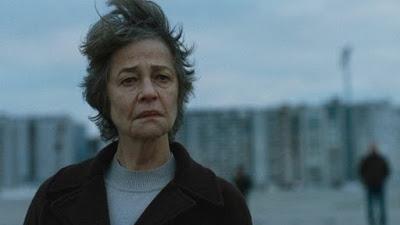
Hannah views a beached whale,
a metaphor of her own life at this juncture
The worth of Hannah as a mature work of cinema is apparent in its ability to unspool its tale by leaving bits and pieces of visuals (sometimes as understated reflected images) and few spoken words (sometimes of people you never see but only hear) peppered across the film. An aging husband is preparing to be incarcerated in a prison for unstated crimes, leaving behind a devoted and elderly wife, in an apartment where their only other companion is a pet dog.
The obvious questions for many viewers would be what was the crime that led to the prison sentence of an old and seemingly affable man?Why are the director/ scriptwriters not revealing it up-front for the viewers? Don’t the old couple have any progeny? When they do not speak much or show emotions, what are they thinking?
Pallaoro’s style is very close to Ingmar Bergman’s, with one major difference.While Bergman would have tended to give considerable emphasis on spoken words in the screenplay, Pallaoro’s and Tirado’s style uses minimal spoken words and emphasizes communication through body language, visual clues, reaction of the title character to strangers and children (such as Hannah’s sudden decision to stop swimming when children enter the public pool). Both directors use theater as a secondary element in their film. Theatre rehearsals and mime are important in Pallaoro’s film as well as it is many Bergman films.
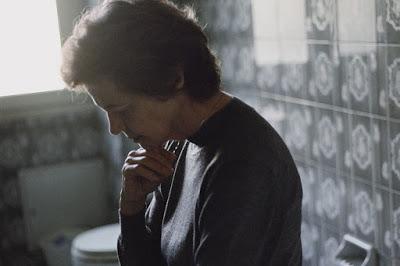
Hannah (Rampling) breaks down in the closet toilet reprising
Bibi Andersson in Bergman's The Touch (1971)
Hannah is like a mystery film, say an Agatha Christie detective tale, where clues are subtly revealed to the viewer without much dialog. The viewer is forced to become the detective adding the dots—mostly visual and a few spoken lines, often by characters that occupy only fragment of screen time.An astute viewer will be able to figure out the crime of Hannah’s husband without it being spoken. The viewer learns the aged couple do have a son and grandson.The grandson wants to meet his grandmother but the son forbids that. The viewer has to figure out the reason by picking up the clues provided in the film. The viewer has to figure out why Hannah does not have any friends or why the film begins with a scream. There have been major films that ended with an anguished scream (Skolimowski’s 1978 film The Shout and Lumet’s 1964 film The Pawnbroker) but Hannah reverses the effect, introducing the viewer to scream followed a rather quiet film in total contrast. The scream, of course, is pivotal to understanding the film as is the long purposeful walk towards the end recalling the walk of Eddie Constantine in Godard’s Alphaville. The walk and the end of the walk state more than what Bergman would have achieved with long conversations. That’s the power of Hannah, the film.
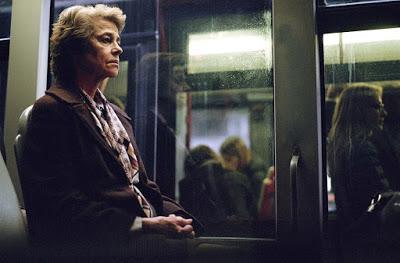
On trains and buses, Hannah witnesses cameos of couples who are breaking up:
in one, the female openly accuses the male of only having interest in sex;
a reflection of what Hannah could have been in the past
If there is one film that Hannah could remind you of, it would be the 1971 French film director Pierre Granier-Deferre’s The Chat, another film about an elderly couple (played by Simone Signoret and Jean Gabin) where they hardly speak to each other in their small apartment they share with their cat. (In Hannah, by contrast it’s a dog,)
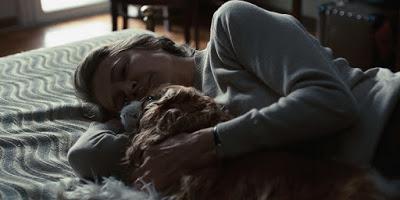
Hannah's only friend her pet dog--which she gives away to new owners.
Human friendship has been lost, possibly because of her past inactions
Hannah is very European in style. While the film is likely to be remembered for Ms Rampling’s performance, the film belongs to the trio of Pallaoro, Tirado and Irvin. Watch out for them; they are indeed talented.
P.S. Pierre Granier-Deferre’s French film The Cat (1971) discussed in the above review has been reviewed in detail earlier on this blog. That film won the Best Actor and Best Actress awards at the Berlin Film Festival, just as Rampling won for Hannah at the Venice film festival.

